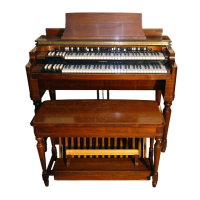CHAPTER IV.
THE ELECTRICAL PRINCIPLE
OF THE HAMMOND ORGAN
HOW MUSICAL TONES ARE CREATED.
HEN you pull out one drawbar of a controller and depress a playing
key, a minute single alternating current generated in the console
is carried through the cable to the power cabinet. Here it is
amplified by the use of normal amplifying methods and caused to operate
standard speaker cones and produce audible sound. The characteristics
of the minute current generated are such that the sound produced at the
speakers is a musical tone perfect in pitch and free from all overtones and
harmonics. In other words, it is a pure fundamental tone.
To this the artist, by using the other drawbars may add other pure tones
which are selected harmonics of this fundamental and thus produce
complex musical tones of a wide variety of qualities. The quality of a
musical tone depends upon its harmonic content. This harmonic content
is added to the fundamental by combining the proper minute electrical
currents at the console through use of the controls provided.
THE GENERATOR.
Let us now consider the generator, located in the console, and see how it
produces the minute electrical currents which create the musical tones.
Refer to Figure 5. A metallic plate (the Tone wheel) about the size of
half-a-crown is arranged so that it will rotate in close proximity to a
permanent magnet. About the permanent magnet is wound a coil. The
illustration clearly shows this arrangement of plate, magnet and coil.
This plate is not circular but has a number of high points equally spaced
around its periphery, as shown. As it rotates it does not touch the per-
manent magnet, but these high points pass close to the magnet. Each
time a high point passes the magnet it varies the magnetic field and
induces a minute flow of current in the coil. Should the tone wheel
be rotated at such a speed, for instance, that 439 high points pass the magnet
each second, a minute
alternating current of a
frequency of 439 would be
generated in the coil and
flow in the circuit with
which it is associated.
Such a frequency of 439
when converted into sound
would be "New Phillhar-
monic" Pitch "A."
Now in the generator there
are 91 such plates, all per-
manetly geared together
Page Eighteen

